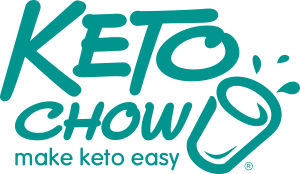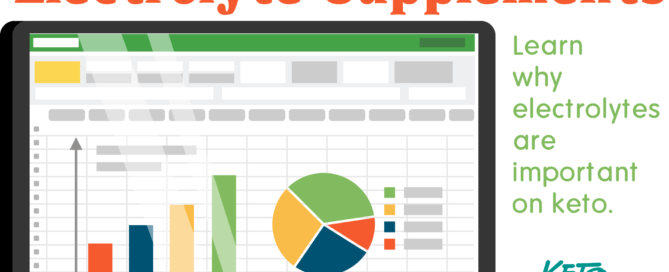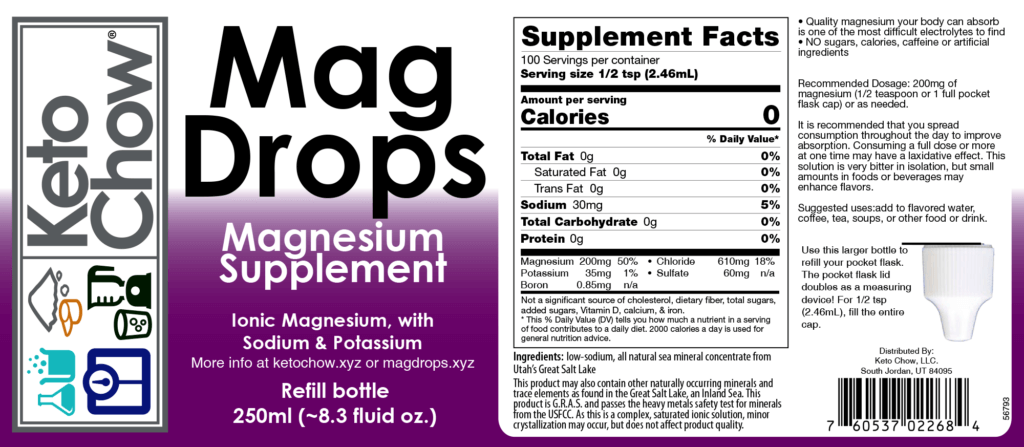Comparison of electrolyte supplements and the importance of electrolytes on Keto
Electrolytes are super important when doing anything that lowers your insulin. That could be simply not eating a lot of sugar and refined carbohydrates, doing intermittent fasting, doing extended fasting, OR switching to a well-formulated ketogenic diet and lifestyle. By far, one of the most important electrolytes is sodium, which is funny because it’s one of the easiest to get (SALT!) and yet it’s one of the more controversial electrolytes due to decades of ignorance and misinformation. If you want the full story on salt, I’d recommend checking out the work of Dr. James DiNicolantonio – he does a far better job of explaining the science behind salt and its importance than I ever could.
The short version of why salt is so important to those lowering insulin is this: as insulin goes down, that signals to the kidneys they no longer need to un-naturally hold on to so much sodium. If your supply of sodium is low, your kidneys will start to dump potassium instead, and if potassium and sodium are low then magnesium will go “out the window” and into your toilet. From a diet and nutrition standpoint, sodium is “cheap” and plentiful. Potassium is “expensive” and harder to get. Magnesium is extremely “expensive,’ difficult to find, and even harder to find in a form that can be absorbed readily by humans. Magnesium deficiency is widespread and difficult to treat.
So: keep your salt intake adequate to preserve potassium, and especially magnesium.
Our bodies are really good at maintaining blood levels of electrolytes in a tightly controlled range, to the extent that testing the efficacy of topical (applied via skin) magnesium supplements is practically impossible (you would need to cut out a chunk of skin after application and test it for minerals BEFORE it enters the bloodstream). If and when electrolyte levels in the blood begin to drop, “reserve” electrolytes will be pulled from muscles, bones, and other tissues to maintain the blood levels of the electrolytes. This will first manifest as a headache or fatigue (the dreaded “Keto Flu!). If magnesium is low, it will often show up as muscle cramps and eventually as weakening of bones.
If you have high levels of electrolytes, your body gets to do a few things. First, it’ll store the electrolytes away for later use when levels are low. After all the storage space is full, it’ll tell your kidneys they don’t need to re-absorb as much. This is a key thing I learned from Dr. DiNicolantonio: your kidneys have to pull out all of the electrolytes, along with the toxins and water that’s being filtered out. Then, based on insulin and other signals, the electrolytes and other needed nutrients are pushed back into the blood as needed. If there isn’t a need to get back some of those minerals, it’s LESS WORK for the kidneys.
Again: an overabundance of electrolytes will generally represent LESS WORK for the kidneys. Sort of “oh, you already have enough of that stuff, OK I’ll take a break then!”
Can you overdo it on electrolytes? Yes, but the result is typically far better than a deficiency. Your sweat might be a little saltier, your urine may be a little more expensive; and in extreme cases of high electrolyte intake, you may have an extra bowel movement to clear out unabsorbed electrolytes (especially too much magnesium).
Saltier sweat vs. the prospect of headaches, fatigue, and cramps – I typically go for more electrolytes. The question becomes: how do you GET those electrolytes?
For sodium, the easiest, cheapest, and most savory (see what I did there?) is simply salt. For that, I cannot recommend Redmond Real Salt enough. It’s fantastic and it’s what we use for salt in our Keto Chow shakes (despite the issues with a bit of grittiness). Salt your food, salt your water, add extra salt to your Keto Chow shakes! If you’re doing an extended fast, you can also use the Keto Chow Fasting Drops which we created at the request of Megan Ramos from The Fasting Method.
Potassium is harder to get. You can use some “Lite Salt” (Potassium Chloride). You can eat some avocados or other foods high in potassium, or at least that historically have been high in potassium.
Magnesium is hardest of all and suffers from the same problem as potassium, but to a greater degree: the process of growing food and then shipping it away to be consumed breaks the nutrient cycle, causing modern foods to have far lower levels of magnesium, potassium, and other minerals than they typically would have had historically – that article only talks about vegetables and fruits but the meat that grows from eating plants grown in depleted soils suffers the same effects. Getting magnesium is further frustrated by the FORMS of magnesium typically found in magnesium supplements: Magnesium Oxide – it looks great on a supplement label with high amounts of magnesium… that YOU can’t use. Humans aren’t very good at absorbing magnesium that’s bound to oxygen, the efficiency is typically in the single percentages. Magnesium Citrate is absorbed easily by is also used as a potent laxative. Magnesium Chloride, Malate, and Glycinate are better with the latter two being magnesium bound to an amino acid and the former being magnesium bound into a chloride. Any magnesium supplement that doesn’t use a QUALITY magnesium you can absorb is worse than worthless – it’s a false sense of hope that you’re getting magnesium, that you simply will not.
OK, let’s compare some Electrolyte Supplements!
Prompted by an exchange on Facebook, I decided to put together a spreadsheet that would compare various electrolyte supplements, with breakdowns on exactly what you are getting for your money. How much 1000mg of potassium costs in a specific supplement. How much 1000mg of quality, bioavailable, Magnesium costs. How many total milligrams of electrolytes are you getting in each dose and what each milligram of minerals costs. You’ll find that different electrolyte supplements target wildly different doses, with some at 670mg of electrolytes in a half teaspoon, and others at 4400mg in a tablespoon! Breaking it all down is the only way to compare rock salt to rock salt.
In the comparison sheet, you’ll find that the least expensive supplements by cost per 1000mg of TOTAL electrolytes is sorted to the top. You can change the sorting order by going to the menus and selecting Data > Filter Views > and selecting one of the saved views. Or you can use one of these handy links to look at electrolyte supplements according to your personal electrolyte needs:
My plan is to continue to add additional electrolyte supplements to the list as I find them, and as people direct them to me, similar to the comparison of keto “meal replacement” options you’ll find elsewhere on this site.
You’ll notice that the Keto Chow Daily Minerals tend to be one of the least expensive (and usually IS the least expensive) options available for all 4 sorting methods (except sodium, it’s hard to beat Real Salt at that!). When we collaborated with Dr. Ken Berry to create the Daily Minerals, the primary purposes were to:
- Replace the minerals missing from modern diets due to the aforementioned depleted soils.
- Reduce the number of supplements people needed (frankly, I think Dr. Berry wanted fewer bottles of stuff at his house, so he had a custom supplement made just for him!).
- Use the best versions of the minerals possible with all pre-dissolved in their ionic state, ready for easy absorption.
- Not have anything added: no colors, no sweeteners, no flavors. If you want to add your own lemon juice or coffee, go for it. Want it straight because you are fasting or want to cook with it? also great.
- Include trace minerals, some only a few parts per million, to help with other as-yet-undocumented benefits.
- Price it as low as possible, while still being able to pay people to ship orders and keep the lights on.
How do the other Keto Chow Electrolyte supplements fit into the formula then?
If you’re like most people and not using the Keto Chow shakes for ALL of your 3 meals a day, we recommend using the Daily Electrolytes to establish a “baseline” of daily electrolyte intake. You’ll be “done for the day” for several with just that one dose, but you will still need more of other minerals – especially sodium and potassium. For those additional electrolytes: you can get them from the food you eat or drink. Or, if you need additional supplementation, from supplements including the Keto Chow Electrolytes. We have 3 different supplements available that you can use whenever you feel like you need more specific electrolytes:
- Keto Chow Electrolyte Drops – designed to give a solid, balanced blend of sodium, potassium, and magnesium in high-quality forms you can actually absorb. Most people that just want to supplement electrolytes like this the best. No colors, sweeteners, or flavors. Works really well on steak or burgers, incidentally (no worries about heat degradation!).
- Keto Chow Magnesium Drops – introduced to help Miriam stop getting headaches and muscle cramps at night, also helps her sleep better. Guess what, it’ll probably do the same for you! Uses a high-quality magnesium chloride concentrate and has a small amount of sodium and potassium, along with other trace minerals.
- Keto Chow Fasting Drops – very high in sodium, with a workable amount of magnesium and potassium. The potassium in the Electrolyte Drops was too high for Megan Ramos of The Fasting Method, who asked us to make one that was more suited for their patients with kidney issues. Whatever Megan wants, Megan gets. The Fasting Drops are especially suited for dosing up sodium during an extended fast where insulin gets REALLY low and sodium requirements go up substantially. Still no flavors, sweeteners, or anything else to derail you while fasting, still has the same trace elements.
If you do happen to be using Keto Chow shakes 3 times a day (which isn’t required nor recommended to most people, it is POSSIBLE, however) then you will NOT need the Daily Minerals, period. You may still need some of the other electrolyte supplements as you feel necessary.


















